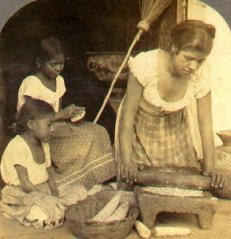Tortilla
|
|
A staple of Mexican and Central American cuisine, a tortilla is a kind of unleavened bread, made from maize corn or wheat flour. The unrelated Spanish cuisine tortilla is a type of omelette.

| Contents |
Tortilla making
Balboa_20_bg_120603.jpg
The traditional tortilla is made of corn or maize since Pre-Columbian times. It is made by curing maize in lime water, grinding and pre-cooking it, kneading it into a dough called masa nixtamalera, pressing it flat into thin patties, and cooking it on a very hot comal (a type of light sheet-metal griddle). In Mexico, particularly in the towns and cities, most corn tortillas are nowadays made by machine and are very thin and uniform, but in El Salvador or Guatemala they are still often made by hand and are thicker. Corn tortillas are customarily served and eaten warm; when cool, they acquire a rubbery texture and are less appetizing.
Traditionally throughout Mesoamerica from Pre-Columbian times into the mid 20th century, the masa was prepared by women using a mano (a cylinder shaped stone like a rolling pin) and metate (a stone base with a slightly convex top for holding the corn).
Most people agree that the traditional stone-ground, hand-made tortillas taste better, but because of the labor required to make these and the common availability of cheap, machine-ground corn flour, traditionally-made tortillas are increasingly less common. Most restaurants proud of their traditional fare, however, will have at least one woman bent over a hot comal, turning out an endless stream of piping-hot, hand-made tortillas.
The wheat flour tortilla was an innovation after wheat was brought to the New World from Spain while this region was the colony of New Spain. It is made with an unleavened, water-based dough, and pressed and cooked just like corn tortillas. These tortillas are very similar to the unleavened bread popular in Arab, eastern Mediterranean and southern Asian countries, though thinner and smaller in diameter.
Tortillas vary in size from about 6 to over 30 cm depending on the region of the country and the dish for which it is intended.
Among tortilla variants (without being, strictly speaking, tortillas) there are pupusas, gorditas, and tlacoyos. These filled snacks can be found in Mexico, Guatemala, El Salvador and Honduras. They are smaller, thicker versions to which beans, chicharrón, nopales or other ingredients have been added. They are customarily cooked on a greased pan.
In Argentina, Bolivia and southern Chile, the size of the tortillas is smaller, and they are generally more salty, made from wheat or corn flour and roasted in the ashes of a traditional adobe oven. This kind of tortilla is called Sopaipilla. In Chile and Argentina it may also be sweetened after being cooked by boiling in sugar water.
Spanish tortilla
The Spanish tortilla is basically an omelette. An ordinary omelette is called tortilla francesa, or simply tortilla. A kind of thick potato omelette, usually eaten at room temperature, is referred to as tortilla de patatas, tortilla española or tortilla de huevo.
See also
Compare
de:Tortilla de harina es:tortilla fr:Tortilla ja:トルティージャ pl:Tortilla pt:Tortilla sv:Tortilla simple:Tortilla
